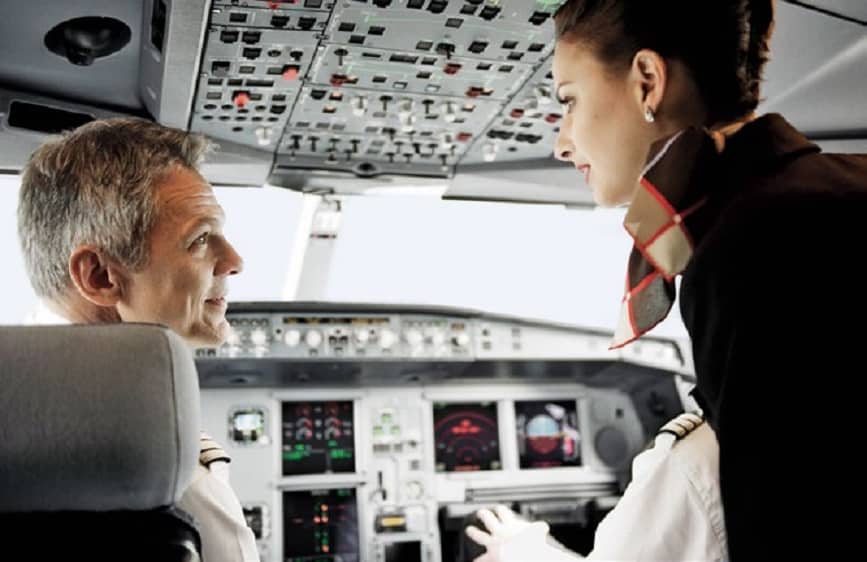How do pilots increase their resilience?
Flying is very complex. Pilots have to monitor and control a multitude of systems and react to changes at short notice. The importance of these skills for occupational safety was investigated by a student from the School of Applied Psychology FHNW together with Swiss International Air Lines.

Sow versatile aviation professions are, they require just as much discipline, knowledge, concentration and finesse. In addition to handling the complex technology, the professional tasks of pilots include planning for events such as safety-relevant weather changes or reacting to them ad hoc. Finally, the cockpit crew learns from extreme experiences for further flights.
Aviation combines high-risk professions that can be equated with engineers, medical professionals or rescue workers. Christian Kunz, a student at the University of Applied Sciences Northwestern Switzerland FHNW, drew on theoretical concepts of "resilience engineering" for his master's thesis in applied psychology by examining the interaction of complex technology and pilot profiles.
"Resilience engineering is concerned with the ability of systems to respond to expected and unexpected changes or critical events in such a way that safe functioning is maintained, "ideally even making the system stronger," says the industrial psychologist. But how do you develop continuous resilience in a dynamic environment?
Is resilience measurable?
There are now four basic skills of resilience:
1.anticipation
2. surveillance
3. reaction
4. learning
One of the central concerns of resilience research is that people are and remain healthy and productive at work and in the organizational context.
Christian Kunz was able to win Swiss International Air Lines for his master's thesis. One of his contacts, Thomas Bolli, is himself a pilot and Head of Safety at Swiss International Air Lines. "Resilience in the cockpit consists of allowing the different experiences, skills and perceptions of the crew members to interact in an optimal way. This requires a working atmosphere that allows and promotes solutions from colleagues with a younger seniority.
The measurability and analysis of the four basic skills were the most important criteria in Christian Kunz' thesis. Ultimately, it was also a question of definition what is really subsumed under the theoretical basic skills. Here Kunz relies on further concepts of work psychology, in particular on so-called "detailed abilities or attitudes".
Kunz: "There are various social science methods for measuring skills", each of which would have advantages and disadvantages in terms of the targeted gain in knowledge. The FHNW student emphasises: "The extent to which reliable and valid measurement results are ultimately achieved is therefore largely a problem of measurement theory and statistics.
In the literature, the four basic capabilities of resilience are postulated as a theoretical framework. However, they are far too rough for detailed measurement and must first be made measurable. The latest findings in work and organisational psychology therefore provide the icing on the cake.
Cockpit safety
Systems and units in high-risk areas - which the aviation industry also uses and deploys in many places - must function safely. Tools, people and other elements must be adjusted or adapted as far as possible to a respective everyday situation.
However, sooner or later, nascent researchers like Christian Kunz realize, "People in particular, with their susceptibility to error, are among the constant risks." Furthermore, industrial psychology shows that the ability of people to interact as individuals and organizations also holds a lot of potential to proactively recognize and remedy change and disruptions.
Thomas Bolli, Head of Safety at Swiss:
"Resilience research helps us to better understand and optimize the systemic interaction of man and machine in the complex environment and thus contribute to flight safety." The 4-P model for cockpit operations (A. Degani, E.L. Wiener, NASA) describes the interaction between operational philosophy, policies, procedures and effective practice. In the absence of procedures in an extraordinary situation, for example, the pilot should be able to find a safe and effective solution on the basis of higher-level policies or even the general operational philosophy (e.g. "safety first").
With the help of group and individual interviews, Kunz developed indicators for each resilience basic skill, such as which behaviors offer conclusions about resilience in the cockpit. "For example," says Kunz, "in the anticipation definition, there is a critical reflection of a pilot's own assessments and assumptions. This person would have to be able to say, for example, how the flight will go."
Inferences
The models with the four basic skills and the indicators show in detail how pilots contribute to the "adaptability and resilience of the aircraft system" during a flight. What conclusions can be drawn with the help of Christan Kunz's "Questionnaire" to optimize safety in the cockpit?
Some key insights from the resilience survey:
- )Two in particular are important
Points: (1) To what extent does the
Swiss education and training
contribute to the development of the defined resilience skills?
(2) What capabilities of pilots must be present in the system in order to flexibly
to changes (risks)
customize in flight
to be able to? - )The survey (measurement) shows,
the extent to which the respective skills are differentiated and can be
change over time. Continue
will be professional differences
(e.g. between captains and
Co-pilots, between long and
Short-haul pilots, pilots with
different years of service)
registered. These data give
Notes regarding stress and strain in the cockpit/
Airplane.
Models can be used to represent complex issues in a simplified form. Mechanisms of action and interrelationships can thus be illustrated in a much more comprehensible way. The Head of Safety at Swiss International Airlines also sees at least as great a benefit of such models in the discussion of findings. This increases the general comprehensibility.
"It is important to know that damage that occurs is dealt with as a reactive process, detached from questions of guilt or personal accusations. One should learn emotionlessly from existing damages and take them into account in the future without personal reasons," says the former trainer and Swiss manager. "The human being is and remains not
is not only a risk factor, but also a crucial security resource," Kunz emphasizes. "Which concrete skills ultimately contribute to safety is the crucial point. A pilot should not only be self-critical, he should also still be optimistic in extreme situations."
Critical skills
Kunz admits, however, that his thesis cannot be applied across the board in Swiss International Air Lines' operations: "The questionnaire cannot simply be transferred to other Swiss employees (e.g. the cabin crew). For this, preliminary investigations would first have to be carried out by means of interviews, indicator development and new modelling."
Flight operations must be understood as an ongoing and safety-promoting process dominated by people, technology and diverse environmental levels. This interplay has become increasingly complex in recent decades - in addition to the many improvements - due to increasing development. It therefore harbours many risks, some of which are new.
"Nowadays, disruptions are hardly caused by technology; it's more about human and organisational factors as well as environmental influences," says Thomas Bolli. When people are involved, resilience takes on a whole other dimension - "More and more seats on a plane, unforeseen waiting times, fear of flying or terror, more intense weather phenomena, etc. can lead to stress reactions that put the crew's resilience to the test."
Here, the Swiss crew practices psychologically comprehensible manners. Resilience at Swiss is first and foremost an awareness-raising measure. When it comes to safety in the cockpit, the purpose of the flight is made clear first, and only then are the actual resources under the principle taken into account:
"Safety first. Here, the assessments of the crew members play the most important role.
The student at the University of Applied Sciences is convinced: "In principle, Swiss now has the possibility to use my measuring instrument in the sense of trend monitoring. This would allow a critical development to be detected very early (ideally before a safety risk occurs), assessed and appropriate procedures initiated.
The master thesis "Resilience of pilots in the cockpit at SWISS" by Christian Kunz was supervised by Prof. Dr. Toni Wäfler, University of Applied Psychology FHNW.









